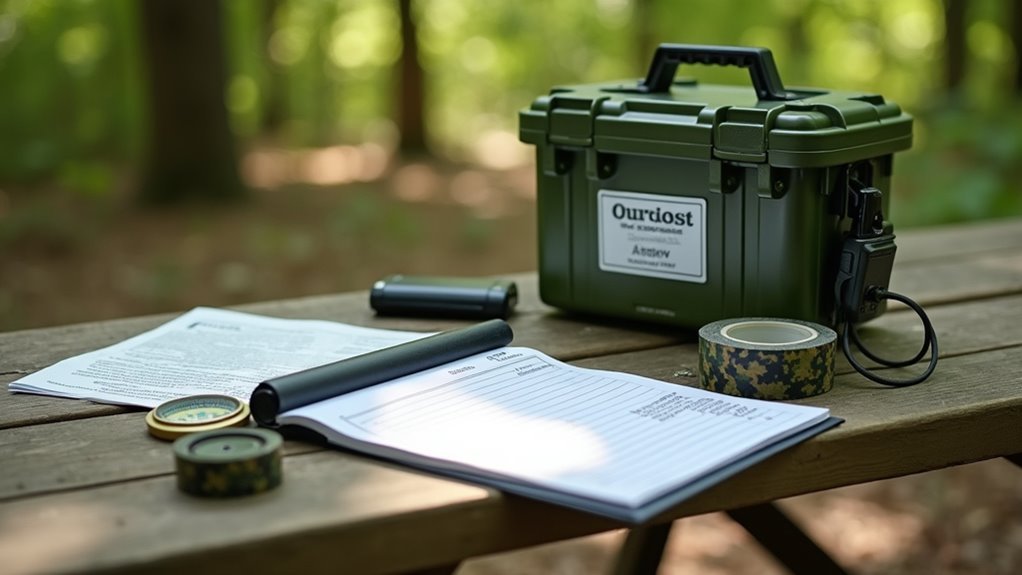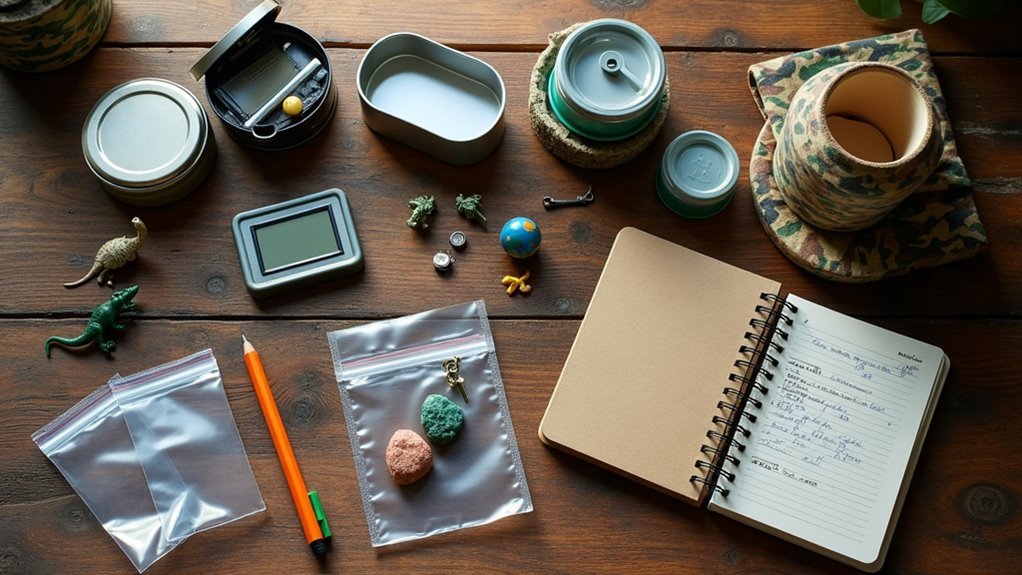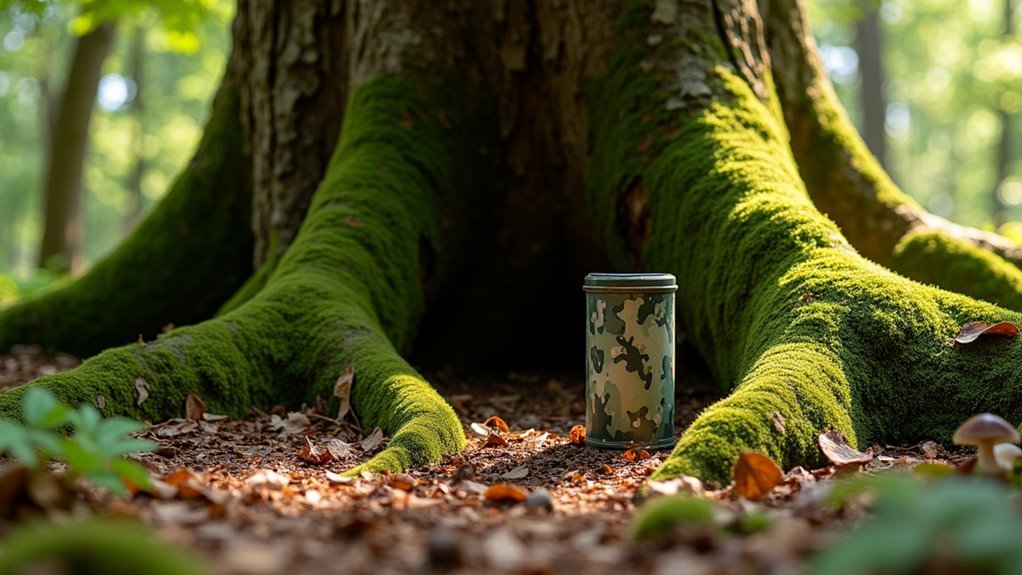Some of the links in this article may be affiliate links. If you make a purchase through these links, we may earn a small commission at no extra cost to you. Thank you.
I’ve been hiding geocaches for over a decade, and I still remember the thrill of placing my first one. If you’ve been hunting caches and now want to create your own, you’re in for a rewarding experience. I’ll walk you through everything—from choosing the perfect spot to maintaining your cache long-term. Trust me, there’s nothing quite like seeing others discover your hidden treasure for the first time.
Understanding Geocache Guidelines and Requirements

Why is it so important to follow the rules when creating your first geocache?
Well, I’ve learned the hard way that ignoring guidelines can lead to your cache being rejected or removed.
Before you hide your cache, make sure you understand the basic requirements on the geocaching website.
Your cache must be at least 528 feet from other caches—this prevents overcrowding and, honestly, makes the hunt more fun!
Respect the 528-foot rule! It prevents cache congestion and creates a more exciting adventure for all treasure hunters.
You’ll need permission if placing on private property or public parks.
I think this is just common courtesy, but it’s also required.
When selecting GPS coordinates, verify accuracy and make sure your cache is well hidden but not buried—that’s actually against the rules.
Oh, and avoid sensitive areas like airports.
Trust me, properly following guidelines makes the experience better for everyone!
Selecting the Perfect Location for Your Cache
Where should you place your first geocache?
I’ve found that the perfect geocache location requires careful consideration.
First, make sure you’re at least 528 feet from other caches near you—this is non-negotiable in the guidelines.
I think park benches, tree hollows, or any spot where X marks the spot on your map can work well as a starting point.
When selecting locations you might use, consider areas with interesting features—maybe a historic site or scenic overlook where cachers will enjoy spending time.
Just don’t hide it where the bench unsearched might attract unwanted attention!
Choosing and Preparing Your Geocache Container

When I created my first geocache, I quickly learned that the container is actually the heart of your entire setup.
You’ll want to select something waterproof and durable—I personally recommend ammo boxes or well-sealed plastic containers that can withstand whatever Mother Nature throws their way.
Before hiding your cache, take the extra step to double-seal important items like logbooks in zip-lock bags, because trust me, nothing disappoints finders more than discovering a soggy, unusable logbook after their exciting hunt.
Container Selection Basics
Selecting the right container for your geocache is probably the most crucial decision you’ll make as a new cache owner. The size of the cache determines what you can fit inside—whether it’s just a small notebook or various swag inside for trading. Remember, cachers will need to find the container, so choose wisely!
| Container Type | Size | Best For |
|---|---|---|
| Nano | Pencil eraser | Urban hides |
| Micro | Film canister | Limited space |
| Regular | Shoebox | Trade items |
| Large | Ammo box | Multiple items |
In my experience, waterproof and airtight containers are non-negotiable—nobody wants to find soggy logbooks! I prefer military ammo boxes for larger caches since they’re practically bombproof. For smaller hides, maybe try a camouflaged container that matches your hiding spot. Don’t forget, cachers often bring their own pen, but durability is key regardless of size.
Weatherproofing Your Cache
Now that you’ve chosen your container, proper weatherproofing is the next step that’ll make or break your geocache’s longevity.
I’ve found that military ammo boxes work amazingly well since they’re designed to be airtight—perfect for protecting your logbook from rain and snow.
Before you leave your cache, apply weather-resistant sealant around the seals.
Trust me, this extra step is totally worth it!
You’ll also need to bring your logbook and any swap items in a high-quality zip-lock bag inside the container—it’s like insurance against condensation.
I always use a quick spray test on my containers before deployment.
It’s kinda like giving your cache a practice run before it faces real GPS-wielding geocachers with their pens and expectations of a dry place to sign in.
Creating Engaging Content for Your Cache
The heart of a memorable geocache isn’t just its location, but the treasures and experiences it offers to finders. I’ve found that including a waterproof logbook is essential—it’s where geocachers sign the logbook and leave their stories, creating a wonderful connection to the community.
For items to swap, I always include small trinkets of equal or greater value than what might be taken. Foreign coins, toy cars, and trading cards work great! Remember the geocaching golden rule: leave something if you take something.
I also recommend creating themed caches—maybe something reflecting local history. It’s actually more engaging when the items tell a story.
Don’t forget to include an information card explaining the activity for newcomers who might discover your cache by chance.
Reading logs from other geocachers will inspire you!
Hiding Your Geocache Effectively

I’ve found that choosing the perfect hiding spot can make or break your geocaching experience – you’ll want something challenging but still accessible, about 528 feet from other caches.
Camouflage techniques really matter; I like to use natural materials like bark or leaves to help my containers blend in seamlessly with their surroundings.
Don’t forget to factor in seasonal changes too, since that perfect hiding spot under summer foliage might become painfully obvious in winter when the leaves fall.
Perfect Hiding Spots
Finding that perfect hiding spot might be the most exciting part of creating your first geocache. When I started, I learned that geocaches hidden well can feel like finding a shell in the forest—challenging but rewarding!
Remember, as a cache owner, know that geocachers should be able to find the cache within about 30 feet of the coordinates.
You’ll want them to use your eyes, not start poking into dark, dangerous places.
Choose low-traffic areas near historic sites or natural features, and always stay at least 528 feet from other caches.
I’ve found that creative camouflage—like attaching bark to containers—works wonders.
Avoid steep hillsides or burial spots (that’s against the rules).
The golden rule of geocaching: Leave no trace when placing your cache to find.
Camouflage Techniques Matter
When it comes to hiding your cache effectively, camouflage isn’t just decorative—it’s essential to creating that “aha!” moment geocachers love.
I’ve found that selecting colors matching your environment makes all the difference—think earth tones while hiking through forested areas where millions of geocaches hidden worldwide blend seamlessly with nature.
I like to glue natural elements directly onto containers—maybe an oyster shell in coastal areas or bark in woodlands.
It’s important, though, that whatever adhesive you use won’t harm the environment.
When geocachers are hiking with a tech-aided hunt that exercises both mind and body, they appreciate thoughtful concealment.
While camouflaging is technically optional in free Geocaching, I’d definitely recommend it.
Oh, and while you’re out there, why not pick up any litter?
Cache In Trash Out (CITO) is something we should all practice!
Consider Seasonal Changes
Seasons dramatically transform the landscape where your geocache hides, and failing to account for these changes might leave seekers frustrated with an impossible hunt.
When I place caches, I think about how they’ll fare year-round.
In winter, I position them at least 1-2 feet above ground to prevent snow burial—seekers might need extra batteries since cold drains them faster.
During spring, I keep track of vegetation growth that could conceal access points.
Summer caches need shade, just like you need to stay hydrated and energized during your hunt.
If you use the app to find my autumn caches, bring bug spray since exposed locations after leaf-fall attract insects.
Always position caches 3-5 feet above potential flood levels, and remember to log everything back online when you’re done!
Publishing and Maintaining Your Cache
Now that you’ve designed and hidden your geocache, it’s time to share it with the world!
You’ll need to sign up for a free account on Geocaching.com or use the Geocaching app on your smartphone to publish your cache.
When listing, provide precise coordinates and a detailed description to help seekers.
Remember, your cache will undergo review to verify it’s at least 528 feet from other caches – one of many guidelines you’ll need to follow.
Once published, you should regularly check the latest activity on your cache page.
I’ve found that monitoring logs helps me know when the logbook is full or if maintenance is needed.
As the owner, it’s your responsibility to keep your cache in good condition.
Just bring a pen and visit periodically to make sure everything’s shipshape!
Frequently Asked Questions
How Do I Start Geocaching for Beginners?
I’d create an account, download the geocaching app, and learn GPS basics. Pack gear essentials, practice navigation skills, and follow safety measures before hunting caches. Join community events, prepare for trails, and remember to sign log entries.
How Do I Make My First Geocache?
I’d select a spot, choose a container size, add a log book and some swag, then weatherproof it. Consider a theme, camouflage tips, GPS accuracy, and create clever hints for finders.
Do People Still Geocache in 2025?
I’ve watched geocaching enjoy a digital revival in 2025. The community shift shows strong global growth, with youth trends particularly positive. Tech adaptation has enhanced future engagement while maintaining its environmental role.
What Are the Three Main Rules of Geocaching?
I’ve found the three main rules of geocaching are: Leave No Trace (addressing environmental concerns), Cache In Trash Out (reflecting community standards), and if you take something, leave something of equal value (preventing common violations).